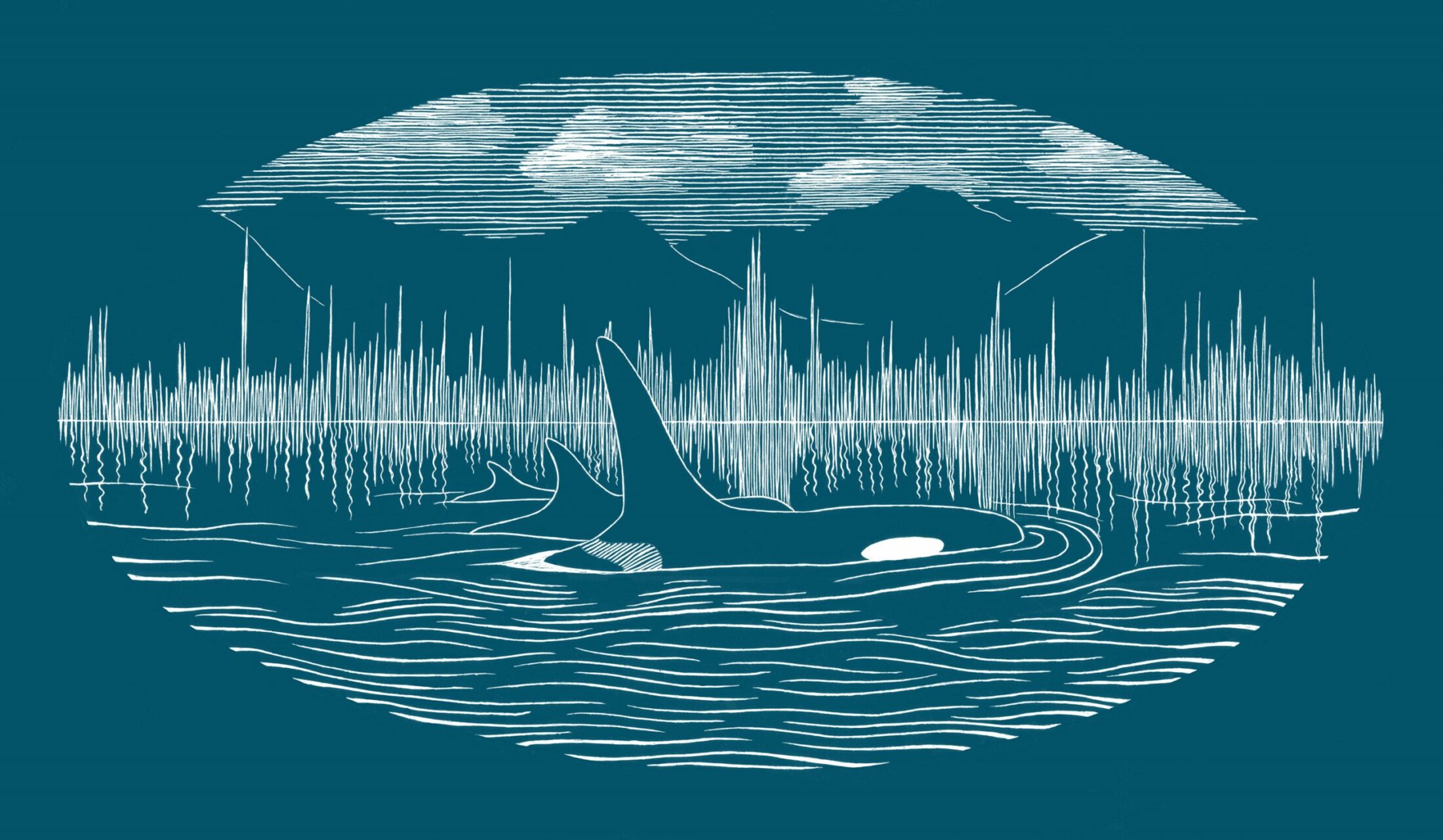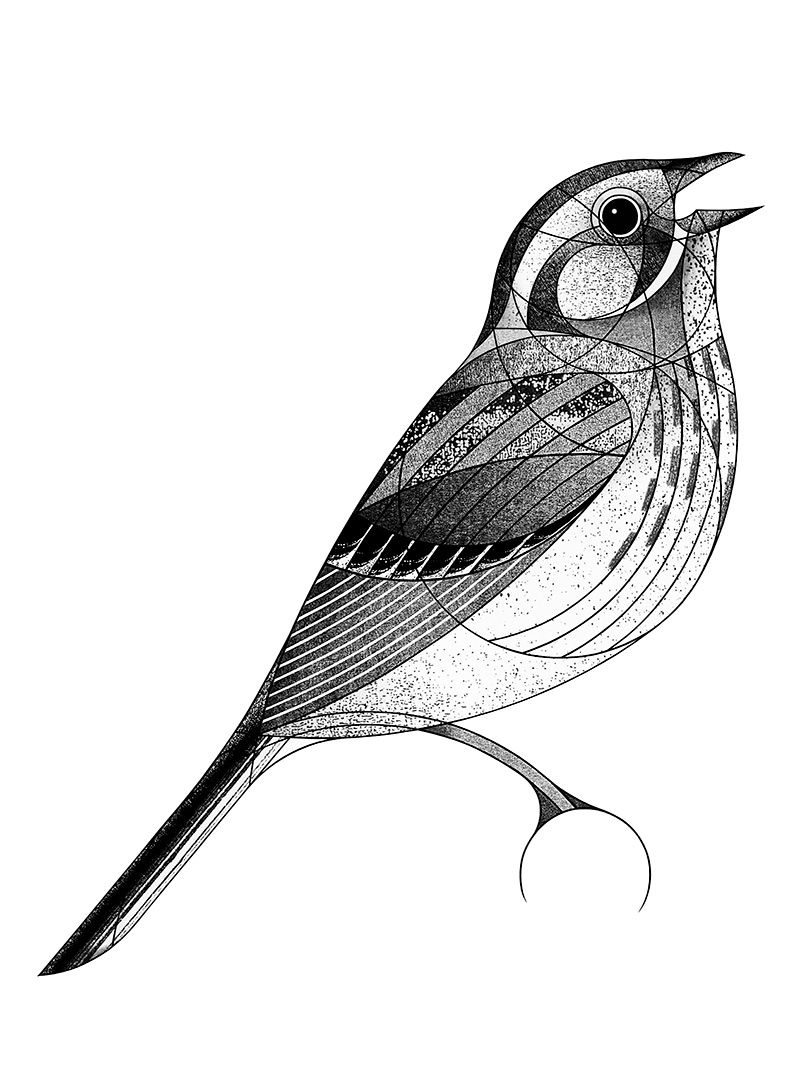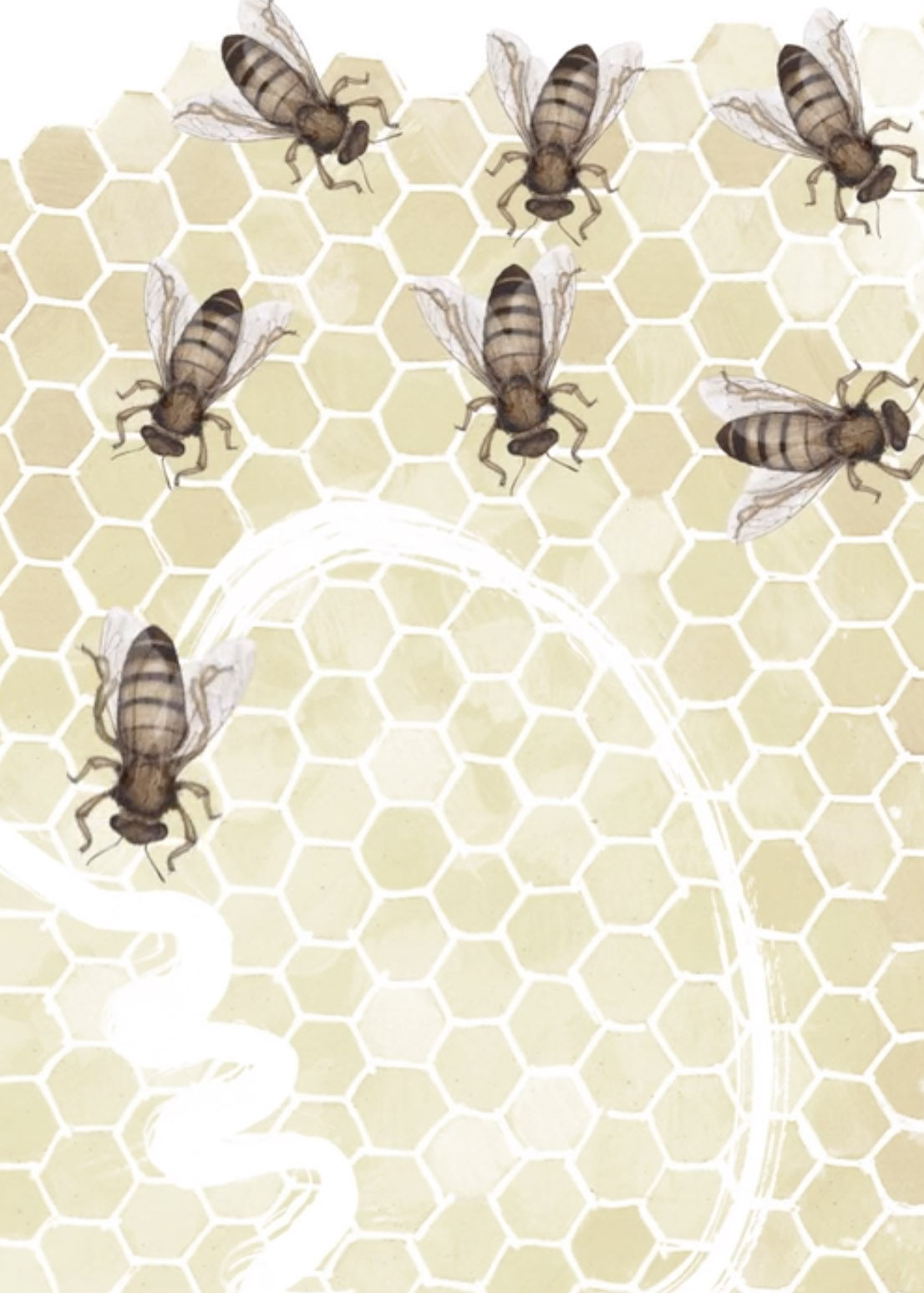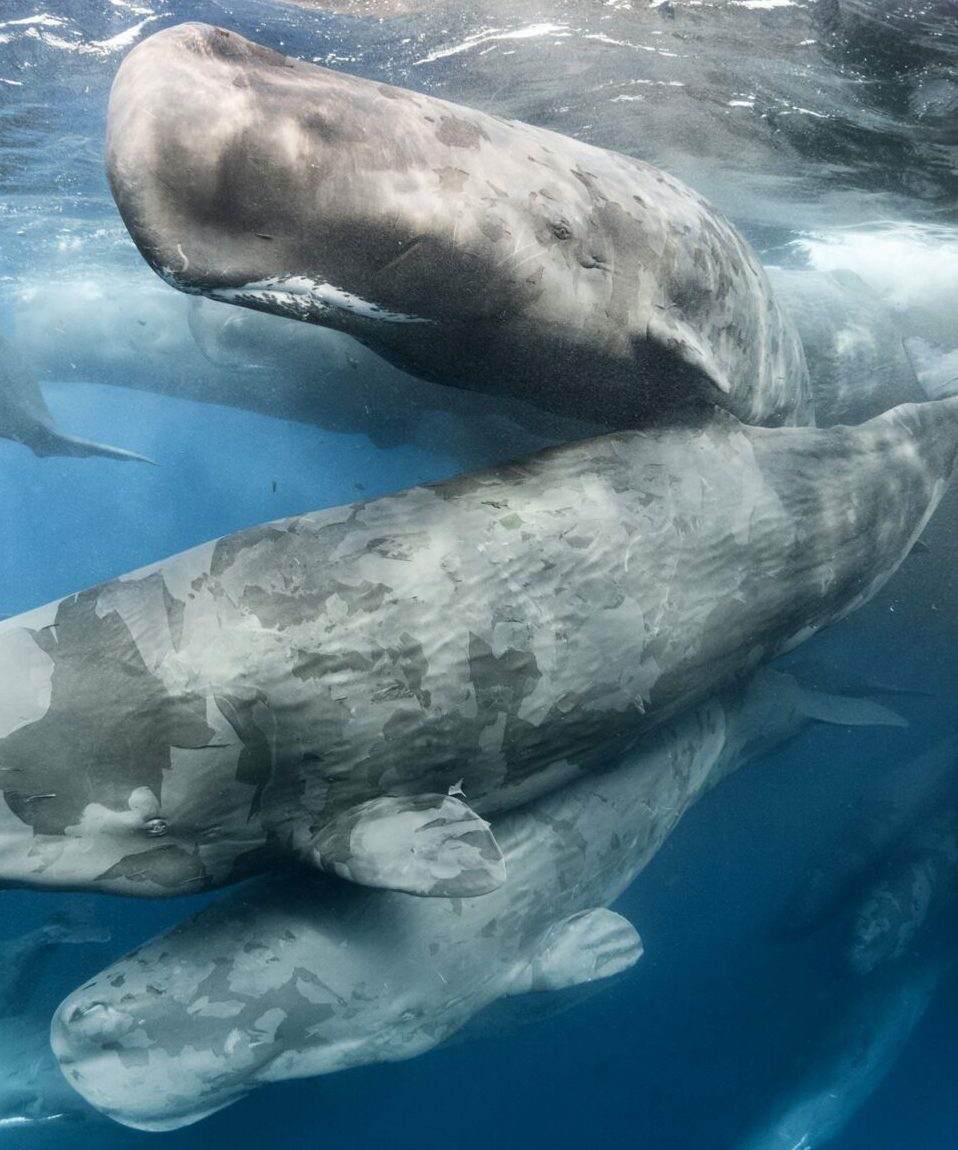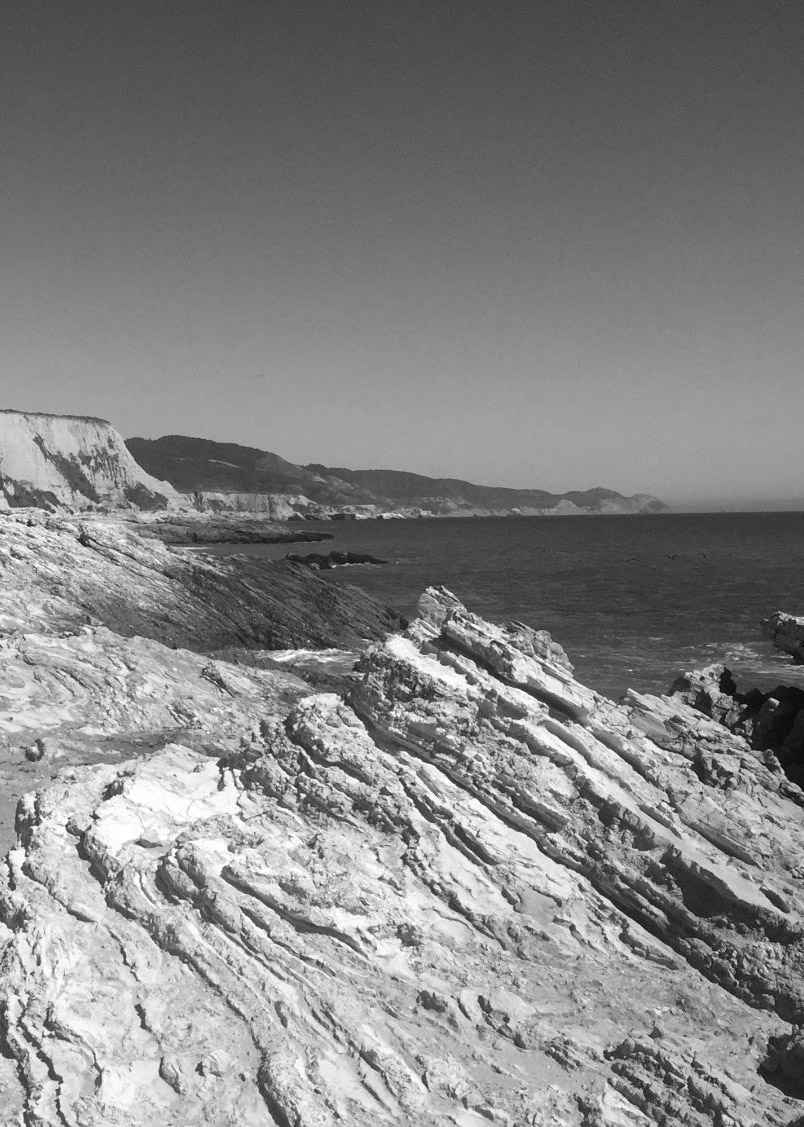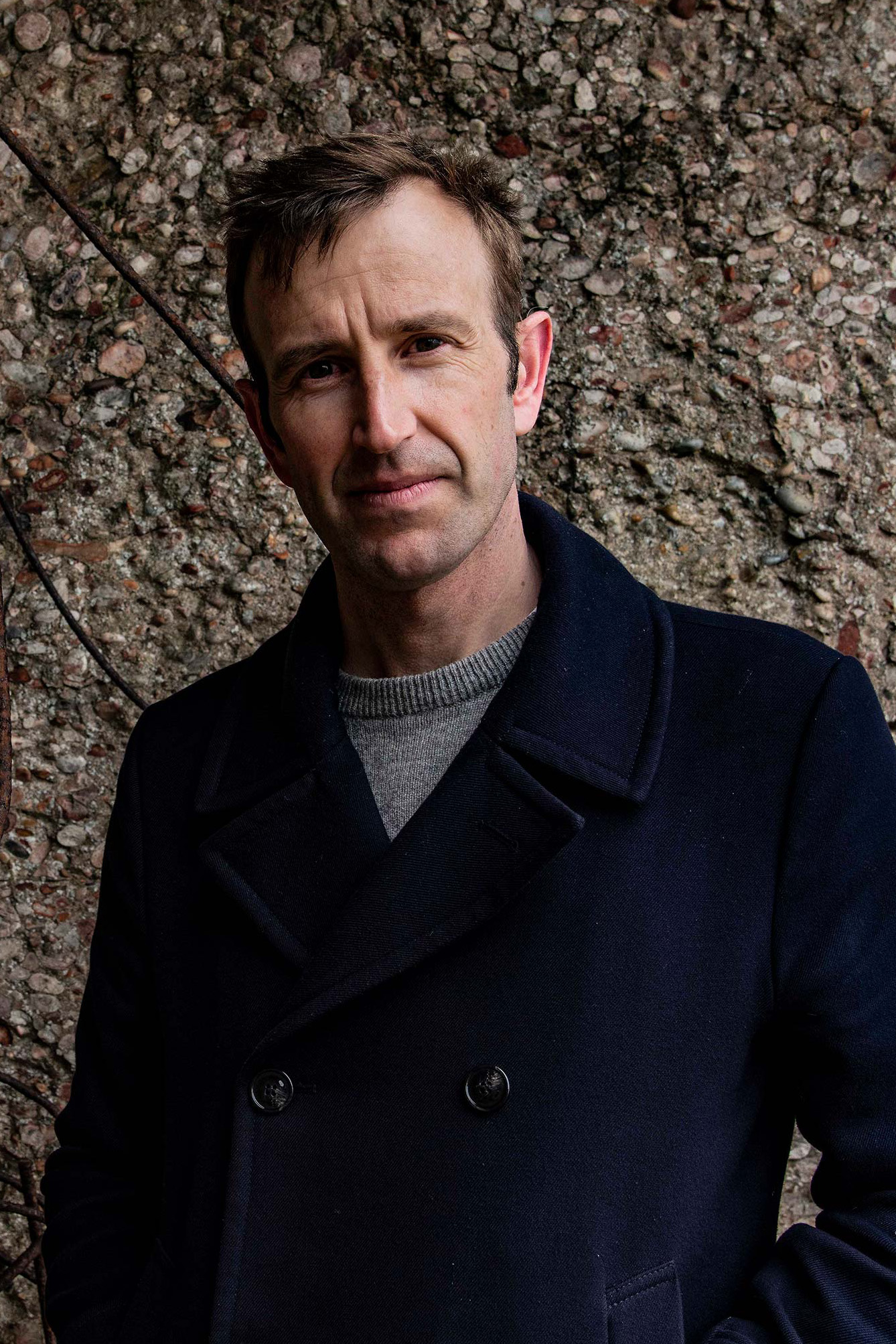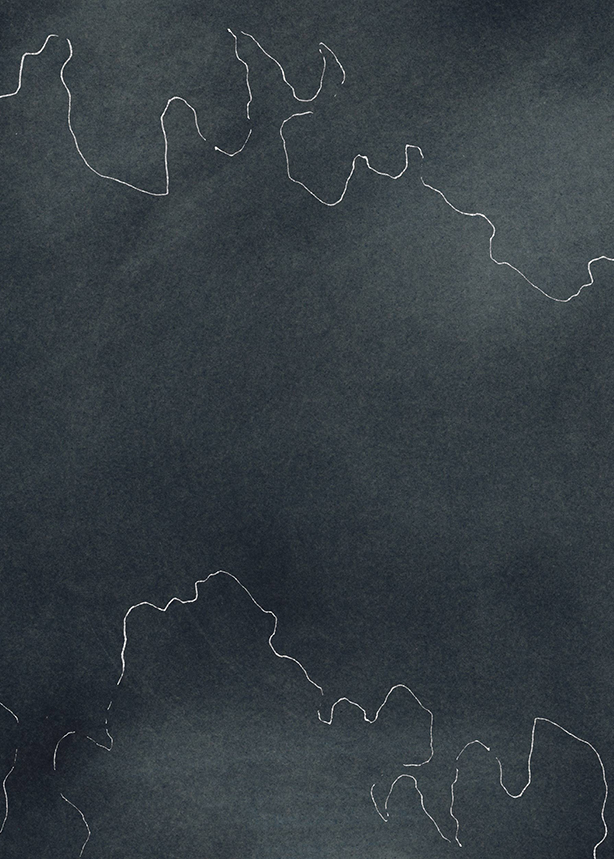Charles Foster is a writer, barrister, and a Fellow of Green Templeton College, University of Oxford. He is the author of more than twenty books, including Being a Beast: Adventures Across the Species Divide, The Sacred Journey: The Ancient Practices, and Wired for God: The Biology of Spiritual Experience. His most recent book is Cry of the Wild: Eight Animals Under Siege.
Alex Boersma is a science illustrator, designer, and geologist. She conducted her research on whale evolution at the Smithsonian National Museum of Natural History. Alex creates illustrations that both accompany science writing and stand alone as works of art. Articles on her research have appeared in The New York Times, BBC News, Nature, and The Washington Post.
In an effort to redeem the self-referential, reductionist nature of human language, Charles Foster travels to the Isle of Skye seeking out a language beyond the human in the vibrant and vast communication of the eight remaining Scottish killer whales.
On a gray January day, I sat slumped in a chair in an overheated library. At midday I got up, ate a slice of shrink-wrapped pig from a Danish factory, and went back to my desk.
That same lunchtime, after a morning idling and smooching off the coast of the Isle of Mull in northwest Scotland, the doomed West Coast Community of killer whales drowned a gray seal in a sea cave, bit off its head, and divided the body neatly among themselves: from each according to his ability, to each according to his need. Then all eight of them turned northward. They were going, as they discussed en route, to the Isle of Skye, 120 miles away. They could have gone at thirty-five miles an hour, but today there was no hurry.
Through the swirling offshore fog, a fisherman spinning for bass at the tip of Ardnamurchan saw the notched fin of John Coe,1 an old bull, then tried to take photos and dropped his phone in the sea. A deer stalker, shivering in the heather on the Isle of Rum, lifted his binoculars from the hinds in the valley bottom and watched the killer whales take a porpoise and snap vainly at an eider duck. They celebrated the porpoise and did not resent the loss of the eider.
I celebrated nothing that day. Nor, until the evening, did I move more than a hundred yards. I drank coffee to make the world hum. The killer whales were high on air.
The whales (big dolphins, really) didn’t slow down when the dark seeped from the sky into the sea. They were following an old sea road. The map was carved deep into their brains. They had learned it from an old matriarch who had died a quarter century before, who in turn had learned it from her mother, who had jostled World War I U-boats in the Sound of Jura. They barely needed their echolocation for a journey as routine as this, but the leader of the moment would fire the odd click at the sides of the channel for reassurance, and notice in her bowels the itching swing of the compass as they crossed seams of iron. Because they had killed twice that day and didn’t need to worry about alarming prey,2 they fizzed and warbled through the night.
I didn’t. When darkness fell outside the library, I hoisted myself out of my chair, cycled home to pick up my rucksack, and caught a train to London. At nine I climbed aboard the sleeper train to the north of Scotland. I had spoken to nobody all day and spoke to nobody all night, except to order a bottle of Chianti to make myself feel less guilty about leaving the family. By the bottom of the third glass, I was finding comfort in the fact that John Coe had once been seen on the east coast of Scotland, well away from the West Coast Community’s patch, in a lads’ trip away with a strange male. From which it can be seen that I was taking my morality from killer whales.
For the next ten hours, until I woke up in the Highlands, my world—at its biggest, and during the few moments when I paid attention to it—was about six by ten by eight feet. In fact, it was usually much smaller than that: it was the size of the tiny space inside my head. Only when a killer whale is locked in a crate does its sensory world shrink to less than a sphere with a radius of about four hundred yards—the range of its low-frequency sonar. A killer whale, asked to describe my world, would talk pityingly about sensory suffocation, claustrophobia, and poverty.
I got up as the train rattled toward Inverness, eating eggs and smoked salmon and looking out the window. There wasn’t much point in looking, really. For a tiny fragment of a second, I’d see a red deer on the hill. By which I mean that photons from the deer hit my retinas and were relayed to my brain. But once in my brain, those images became transmuted almost immediately into something that had almost nothing whatever to do with the real deer. They became remembered bits of poems about deer, and physiological facts about deer, and so on.
This is a shame. I expect that a real deer is fantastically more interesting, complex, and charismatic than my thoughts about deer. But I wouldn’t know. I’ve never seen a deer, although on that cold morning, there were hundreds at the trackside. I doubt I ever will. I’m incurably self-referential and, hence, self-reverential. I live in a world of narcissistic abstraction. It’s the fault of my cognition, which is in a demonic conspiracy with language to prevent me escaping from my own skull.
The conspiracy makes me a reductionist: I reduce the world, in all its glory, to a set of propositions, articulated in human words, on a metaphorical sheet of paper. In fact, it’s worse than that. There’s hope if your sheets of paper are merely metaphorical. But I’m a writer, and the sheets of paper are real. Shit!
From Inverness I crossed Scotland to the Kyle of Lochalsh, slung my bag into the belly of a bus, and shuddered off to Uig, at the tip of Skye, facing the Outer Hebrides.
I’ve done this journey many times. I do it now robotically and obsessively, in all seasons. I need to know from the killer whales how to talk and, so, how to redeem language and, so, how to inhabit the world instead of the echoing loneliness of my own head. I can’t stop being linguistic, but perhaps, with the whales’ help, I can be slightly less unsatisfactorily linguistic. Perhaps I can broker a real relationship between language and what it purports to represent. Perhaps language itself can grow under their tutelage.
If language is simply about the transfer of data, a single cetacean is like a significant chunk of the internet.
There was no reason to suppose that they would be there, and an infinite number of reasons to suppose that they wouldn’t. I had never seen them before. I respected them for not showing themselves and wondered what the real things would do to me. I enjoyed the quixotic futility of these trips and was happy with my mere idea of the killer whales.
I slept in a bivy bag on the beach with my head on a stone, hoping stupidly that the stone would act like ear ossicles and amplify and transmit the whales’ clicks, whistles, and calls. Orion strode, an otter undulated along the tide line, a heron stabbed, and I woke up every hour to shiver and drink bad beer from the only shop that had been open.
In the morning, I had a halo of frost when a (very) Scottish policeman, using strings of phonemes, some of which I recognized, asked me what the devil I was doing. There was no answer that could be translated into police-ese. So I got up and sat on a rock instead, which apparently wasn’t such a threat to national security.
And as I dozed, suddenly they were there, four of them—their dorsal fins like birds evolving out of the water: idling, rolling, snorting, wheezing. Up there on the sea’s skin, they are all old men or steam engines. They must resent being tied to the surface air, just as I resent having to go sometimes to London. London is not my life; snowy mountains, boats, and bracken are not theirs.
They have their own mountains, which are just as vertiginous. Those mountains swoop steeply upward (down, in the killer whales’ world, is upward) from just off the shore. At the foot of the sea mountains, just as at the foot of the land mountains, there are swaying groves full of flesh. The whales’ groves are kelp forests, and seals and porpoises weave along sunny or shady paths.
In that short description, there are nouns, verbs, adjectives, and adverbs. The description, of course, falls woefully short of what’s there in the Minch, but (and here, again, is my tragedy) I cite that description to myself even when I’m down (or up) there on the undersea scree slopes with my mask on my face and my tanks on my back. I’ve never seen a deer; I’ve never swum in the sea; I’ve never slept with a real woman. Thanks to language, I’ve only ever masturbated.

The killer whales dived to a labyrinth of honeycombed caves where, last year, a couple of divers ran short of air and tore each other’s face as they scrabbled for the other’s hose. The visibility in the Minch is generally very good, except when the summer plankton blooms, but a storm had churned up the channel, and the whales began to click—sending out pulses of sound that bounce back to their heads and are the building blocks of a model of the world.
It’s not usual to think of echolocating sounds as language, they have many of the characteristics of the language that I use—but are more fecund and less dishonest than my words. There’s a real concordance between the sonic map and the caves. There is little between my words and the caves. Echolocation is a vibrantly reciprocal conversation between the animal and the wild world, of the sort that nature writers can only fantasize and metaphorize about. It is not like other sensations—all of which convey information from an essentially passive outside world. If I put my hand on a cold stone, the cold stone isn’t an active party to any relationship. It’s just there, being cold and stony, and my sensory receptors merely record those facts. But echolocating clicks induce a response from another.
The rocks spat back an answer to the whale: “Here I am: I’ve got a knobble here and a groove there, and I’m made from early Eocene basalt with a bit of mugearite.” And the whale responded respectfully by steering to the left.
Everything soft was transparent to the whale. It saw a seal’s heart pumping, just as you see a fetal heart with ultrasound (and see the heart beat faster as the ultrasound hisses through). It saw blood swishing along the aorta of its own pod sister, and the remnants of the porpoise that they’d caught off Rum being squeezed toward its brother’s anus. And, too, the clicks perhaps play an indirect part in communication with other whales. “Those are Floppy Fin’s clicks,” the thinking might go. “He’s closer to the ridge than I’d be. Typical. Ah, he’s just turned—quite right, too.” They eavesdrop on the conversations with the world that the other whales are having, and there’s nothing like eavesdropping for bonding and gossip.
At the caves, and then up a valley and then down a road paved with Bryozoa, the four called and whistled.3 The calls were a riff around a drone, like Byzantine-chanters on speed, full of contrapuntal syllables and lacy ornaments. But the whistles were electric, the stuff of the big void: think of a toddler manically sliding a rheostat, of sounds squeezing and moaning between slices of blue-and-green water. Sometimes an individual uttered its signature call—“This is Occasus”—or the community’s generic identifier: “We’re the West Coasters, not the Icelanders.”
The sounds are as far from reflexive grunts as Pavarotti was from a doorbell. They are far more artistically individuated than a top-class rendition of Hamlet, because their vocal range is much greater. We English-speakers like to boast about the size of our vocabularies. We would not boast if we understood killer-whale language. We speak using combinations of twenty-six letters. A very small amount of additional meaning is added by frequency modulations. A rising tone at the end of a sentence, for instance, might imply incredulity. But killer-whale sounds range over frequencies at least ten times greater than you’ll hear even at La Scala.4 Yes, they’ve probably got phonemes, words, and syntax, but they’ve got so much more than that.
So far, by and large, we’ve looked only (with our characteristic anthropocentric presumption) at those frequencies cetaceans use that are also audible to us. Yet those frequencies are a tiny fraction of what the whales themselves use. Slow down the white noise of a beluga and you’ll hear an intricately orchestrated symphony over hundreds of octaves. If language is simply about the transfer of data, a single cetacean is like a significant chunk of the internet. One momentary squirt of sound might convey the information in a full-length movie, complete with soundtrack, emotional color, and elaborate choreography.5
To appreciate a movie every one-hundredth of a second, you need serious processing power. Killer whales have it. Their brains are massive. Encephalization quotients (the ratio of brain size to body size) are very crude indices, but even on that basis, killer whales compare favorably with the higher primates, and their cerebral cortices have the luxuriant folding of a prodigious genius.6
There are good reasons to suppose that killer whales have something akin to speech. Their frontal operculum (which, in human brains, is involved in speech) is very large, and the operculum may be connected via a neural highway to the nasal respiratory tract (which is used for vocalizations in cetaceans: they essentially speak with their noses).7 Nuanced voluntary control over vocalization is important: the whole output system gets squashed by the weight of water as they dive, and so, to remain coherent, they need to be able to listen to their own sounds and change the manner of production. It’s very like individual singers in a choir checking that they’re in tune with the others, and it surely implies (as if we needed confirmation) that cetaceans have a subjective sense of self: “That’s my sound, as opposed to Moneypenny’s: it’s rather flat. I need to tighten up my blowhole a bit.” It’s what makes them able to imitate the banal sounds broadcast to them by trainers: names, greetings, and raspberries.8
But speech isn’t the full story. There’s just too much data being transferred, in too many modes. Quite apart from the colossal bandwidths, the transmission happens far faster than it does for us, simply because sound travels four and a half times faster in water than it does in air. I get a suffocating auditory claustrophobia when I’m submerged with my eyes shut. The crash of underwater surf a hundred yards away seems to come from twenty-two yards off. Disentangling all the sounds is strenuous and tiring.
Yes, killer whales can use their sounds for the type of dreary practical conversations for which we generally use the language of Shakespeare and Milton. They’re perfectly capable of coordinating multipronged attacks on the minke whales of western Scotland, using a battery of curt directions, but to say that that’s all their sounds do is like saying that English can do nothing but distinguish between left and right. An intriguing and important study found no strong connection between specific call types and one of four specific behavioral contexts (traveling, foraging, socializing, and resting).9 What was important was the social context. The truly significant differences in vocalizations were determined by whom they were with.10
Most of the speech is bespoke—tailored intimately to the contours of the relationship with other individuals. Presumably, then, its purpose is the fostering of those relationships. In one-hundredth of a second, Moneypenny, down there along the bryozoan road, produced, directed, and screened a movie for John Doe (and no one else), explaining how desolate she was feeling about her barrenness, but how her mood might lift when they got to Ireland later that week. In the following hundredth of a second, John Doe got another auditory movie, even darker this time, about Moneypenny’s own mortality, her neurotic fear about the pain in her abdomen, and her feeling that the Icelanders did things so much better. Perhaps John Doe turned and sympathetically massaged Moneypenny’s kidneys or her lungs or brain infrasonically. Dolphin speech is said to help human mood and health; why not the dolphins themselves? Human words often kill; dolphin words might heal.
There are no monologues in the sea.
Much of Moneypenny’s repertoire was taught to her by her mother. She learned by copying and correction.11 But her personality was very different from her mother’s. Four basic personality traits have been identified in killer whales: extroversion, dominance, carefulness, and conscientiousness/agreeableness. Moneypenny’s mother was careful, and her language teaching majored in prudent ideas. But Moneypenny herself, to her mother’s frustration, was an exuberant extrovert, and some of the vocabulary with which that was expressed was borrowed from a young bull whose head was mashed in his midtwenties by the propeller of a Panamanian freighter. Her mother didn’t hide her disapproval of this delinquency, and their conversations were always rather stilted.
Moneypenny learned, too, from other species and from nonorganic sounds. An abandoned juvenile killer whale off Vancouver Island is known to have copied the barks of a sea lion,12 and Moneypenny, as a calf, loved and learned the songs of seals, the drawl of shingle in an undertow, the thump of ferry engines, the whine of lobsters, and the purring of a wastewater pipe on South Uist.
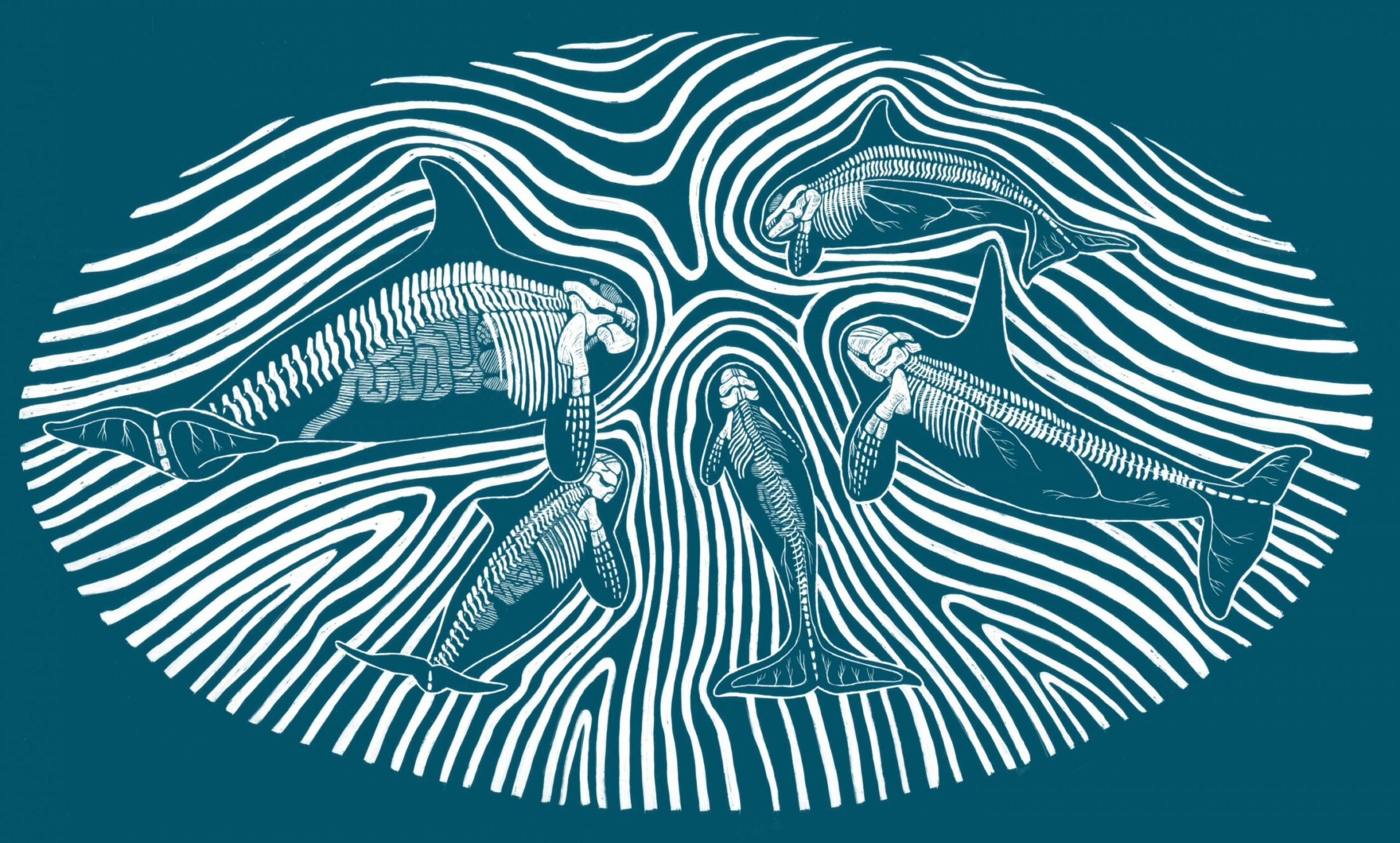
I talk in straight lines. My speech goes direct from my mouth to my listeners’ ears. Sometimes some of the words are snatched away by wind, but the air doesn’t mold them. It is different in the sea. A sound might be carved up or stretched or reflected or somersaulted by a plane separating water of different temperatures or salinities. The very business of vocalizing, then, charts the complexity of the medium through which the sound travels. Salt water talks back. There are no monologues in the sea. There is so much more going on down there.
So much, indeed, that it is nonsense to talk about the “language” of killer whales. Not because it might be an insult to language (and to the pride of those hubristic language users, the humans), but because it is an insult to killer whales to imply that their means of communication are as limited as ours. Language as we understand it is a small part of any organism’s negotiation with otherness.
I’m often frustrated by the inability of my language to reflect the wonder of the world. I intuit that wonder, and then language tells me that I’m getting overexcited and I ought to calm down. But I prefer to trust the intuition. I know that propositions formulated in language can’t do the job. How can I possibly describe my love for my children, my outrage at the cruelty of men, the smell of a wood fire, or the sun on the back of a gull—let alone the dance of these things with one another?
We know from our everyday experience that words fall short of the splendor; that little of our real understanding is mediated through words; that most of what we get even from a formal lecture is subliminal (perhaps communicated by pheromones, or the interlocking of auras, or whatever).
If, when I’m sitting at home in Oxford, I want to taste northernness, I put on the music of Peter Maxwell Davies. Our lives, and the worlds in which we live them, are symphonic. Nothing less than music will do to describe it. Music bypasses our cognitive gatekeepers. It expounds with a power and an accuracy that not even Shakespearean allusion can match. “But what does music mean?” ask the reductionists, hunched over their oscilloscopes. You might as well demand a word-perfect English translation of the Eroica.13
Like ours, the killer whales’ lives can be painted only in an epically symphonic way. And their communication is, in its variety, its scope, and its intensity, far more musical than verbal.
It has been suggested that in humans, music preceded language. I suspect that’s right. Language is all right for lawyers and stockbrokers (although the way they use it makes them wither fast); it is obviously inadequate as a medium for articulating the relationship with the wider world and with one another that is the essence of being human or cetacean. So to realize that essence—to be conscious; to say, “This is me, and I’m standing here, and isn’t it glorious?”—you need music.
We had it. We’ve lost it. Language, which was meant to be a minor functionary—a cog in the machine of comprehension—has taken over the show. But the killer whales still have music. They can teach us how to thrive as humans.
Language as we understand it is a small part of any organism’s negotiation with otherness.
Note what they use their music for: for relationship. Not much of my language, to be honest, is used for that. But their whole lives are relational. The individuals in a community may have radically different personalities, but the boundaries between them are ecstatically blurred. Individuals bleed into one another. The neuroanatomy shows how: killer whales have a relatively greater number of spindle cells (involved in the limbic system’s capacity for empathy, theory of mind, and social processing) than humans.14 Killer-whale empathy crosses the species barrier. No killer whale would rip a human’s calf from its parents, put the calf in a tank, and make money by forcing it to do tricks.
But most of the bonding is with their own kind—and, importantly, with their own group. The West Coast Community sometimes meets the Icelanders. They eye each other with interest and suspicion and pass by. They don’t speak; indeed, they can’t. Their languages are as different as English and Greek.
All the world’s killer whales have a common ancestor just 250,000 years back in their family histories. When the killer whales occupying five cultural niches (two in the Pacific and three in the Antarctic) were genetically profiled, they were found to fall into five genetically very different groups that exactly mirrored the five niches. Culture, it seems, has driven somatic evolution.15 And an important element of that culture is language. The West Coast Community could (or could have, before it acquired some of the highest levels of PCBs ever found in marine mammals) have interbred with the Icelanders. But they didn’t speak, and so didn’t meet (and didn’t meet, and so didn’t speak), and so they didn’t interbreed. Yiddish-speaking Hasidim don’t usually marry Pennsylvania Dutch–speaking Amish, which is a genetic shame for both of them. It’s the same with killer whales.
The West Coast killer whales have paid a high price for the intimacy of their relationships—an intimacy manifested in the parochiality of their language. They are barren because they share too many genes. There have been no new calves since the 1980s, when records began.16
It’s too late for them now.17 The language that makes their relational life rich beyond all human imagining is about to snuff out that life. The remaining eight will soon be dead. With them will die a bejeweled culture, a unique understanding of the ocean, and an irreplaceable way of expressing their own emotional response to freedom and death in the saltwater peaks of Scotland.
This is what I was thinking as I shivered on the rock in Skye, watching the sailfins cutting up the Sound, a hydrophone trailing in the sea. I won’t go there again. It is too sad.
I said that I wanted to learn from them. I think I have learned what I can, and now it has to be put to work. So I packed up my rucksack, hitched a lift, and caught the train back to Oxford, where I’m going to listen to the Bach cello suites and sing more to all the children—conceived with my Irish wife, with whom I share almost no genes, but enough words to get by.
I am very grateful to Andy Foote, of Bangor University, and Lauren Hartny-Mills, of the Hebridean Whale and Dolphin Trust, for their help.
- The names given by researchers to the West Coast Community are John Coe, Floppy Fin, Moneypenny, Nicola, Comet, Aquarius, Puffin, and Occasus. The community is elderly, and unusual for having equal numbers of bulls and cows.
- Volker B. Deecke, John K. B. Ford, and Peter J. B. Slater, “The Vocal Behaviour of Mammal-Eating Killer Whales: Communicating with Costly Calls,” Animal Behaviour 69, no. 2 (2005): 395–405.
- Olga A. Filatova et al., “Cultural Evolution of Killer Whale Calls: Background, Mechanisms and Consequences,” Behaviour 152, no. 15 (2015): 2001–2038.
- Filipa I. P. Samarra et al., “Killer Whales (Orcinus orca) Produce Ultrasonic Whistles,” The Journal of the Acoustical Society of America 128, no. 5 (2010): EL205–EL210; Peter L. Tyack and Christopher W. Clark, “Communication and Acoustic Behavior of Dolphins and Whales,” in Hearing by Whales and Dolphins, eds. Whitlow W. L. Au, Richard R. Fay, and Arthur N. Popper (New York: Springer-Verlag, 2000), pp. 156–224; Jim Nollman, “Whale Communication: The Potential for Language,” Interspecies, 2005, http://interspecies.com/pages/whalmusi.html; Filatova et al., “Cultural Evolution of Killer Whale Calls.”
- Nollman, “Whale Communication.”
- Lars Crawford, “Killer Whales Are Non-Human Persons,” Grey Matters, published December 7, 2013, http://greymattersjournal.com/killer-whales-are-non-human-persons.
- Crawford, “Killer Whales Are Non-Human Persons.”
- José Z. Abramson et al., “Imitation of Novel Conspecific and Human Speech Sounds in the Killer Whale (Orcinus orca),” Proceedings of the Royal Society B 285, no. 1871 (2018): 20172171.
- John K. B. Ford, “Acoustic Behaviour of Resident Killer Whales (Orcinus orca) off Vancouver Island, British Columbia,” Canadian Journal of Zoology 67, no. 3 (1989): 727–745, https://doi.org/10.1139/z89-105.
- Brigitte M. Weiß et al., “Intra- and Intergroup Vocal Behavior in Resident Killer Whales, Orcinus orca,” The Journal of the Acoustical Society of America 122, no. 6 (2007): 3710–3716.
- Filatova et al., “Cultural Evolution of Killer Whale Calls.”
- Andrew D. Foote et al., “Killer Whales Are Capable of Vocal Learning,” Biology Letters 2, no. 4 (2006): 509–512.
- Compare with Nollman, “Whale Communication.”
- Crawford, “Killer Whales Are Non-Human Persons.”
- Andrew D. Foote et al., “Genome-Culture Coevolution Promotes Rapid Divergence of Killer Whale Ecotypes,” Nature Communications 7 (2016): 11693.
- Suzanne Beck et al., “Using Opportunistic Photo-Identifications to Detect a Population Decline of Killer Whales (Orcinus orca) in British and Irish Waters,” Journal of the Marine Biological Association of the United Kingdom 94, no. 6 (2014): 1327–1333.
- Beck et al.
